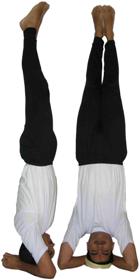Shirshasana Other NamesSirsasana, Sirshasana, Sirshasana, Headstand Posture, pole posture Pose, Topsy-turvy Posture, Vipreet Karni Asan/ Mudra, Vipreeta Karani, Shirsh Asan, Upside down pose, Sirshasana  Description This pose is the most recognized yoga pose than the other poses. Standing on one’s head is called Sirsasana. It is also called the king of the asanas, so one can practice this asana after having mastery in other asanas. How to reach the stretch - Firstly kneel down on the mat. Then interlock the fingers of your hands and place them and your forearms on the extra padding on the yoga mat.
- Keep your elbows close together. Place the back of your head into the hollow of the palms.
- Now, rise up off your knees and take a step or two towards the head.
- Inhale, and slowly raise the legs until they are vertical.
- Now, keep your back straight and try to relax and breathe deeply and slowly from the abdomen.
- Now, concentrate on the brain or the pineal gland between the eyebrows.
How to release the stretch - To release or to come down, bend your knees and lower one leg and then the other.
- For the beginners, just ask your friend to hold one of your legs while you lower the other leg.
Benefits - It promotes hair growth by increasing blood circulation in the scalp.
- The Shirshasana or the headstand increases the circulation to the brain, due to which we can have improved brain functions and increased vitality and confidence.
- Poor blood circulation, fear, sleeplessness, headache, tension, constipation and the problems of eyes and nose can be improved by it.
- It also helps to put the spine into correct alignment.
Caution - Not for the persons who have high or low blood pressure, atherosclerosis (blocked blood vessels), any history of strokes, serious eye disease, pus in ears, suffering from constipation, suffering from neck injury, or also who have organically defective pituitary.
- But after recovering from these diseases you can try do this asana.
Next: Shirsha-Vajrasana
|  Yoga
Yoga  Yoga
Yoga